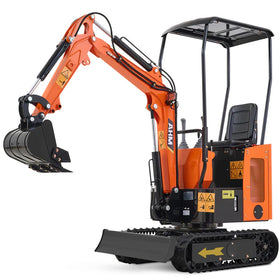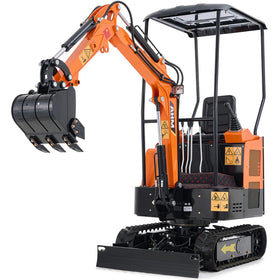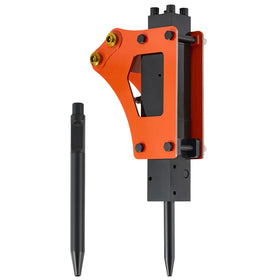How much can a skid steer lift depends on its rated operating capacity (ROC), which ranges from 700 pounds to over 4,000 pounds. If you own one, it is important to know the exact number because it determines what materials you can handle safely and which attachments your machine can support.
Understanding skid steer lifting capacity isn't just about avoiding tip-overs - it affects the productivity, safety around the job site, and how long your equipment will last. On the other hand, picking the wrong machine for your lifting requirements costs money in downtime, repairs, and project delays.

How Much Can a Skid Steer Lift?
Skid steer lift capacity varies dramatically by frame size and design. Most machines fall into the ranges below, mainly based on their construction category.
Small-Frame Skid Steers
ROC Range: 700-1,750 pounds
- Best for landscaping and residential work
- Operating weight: 3,000-6,000 pounds
- Engine power: Under 50 HP
- Typical applications: Interior demolition, tight-space material handling
Medium-Frame Skid Steers
ROC Range: 1,300-2,200 pounds
- Most popular category for contractors
- Operating weight: 5,000-7,000 pounds
- Engine power: 50-70 HP
- Typical applications: Construction sites, general material handling
Large-Frame Skid Steers
ROC Range: 2,200-4,200+ pounds
- Heavy-duty commercial applications
- Operating weight: 7,000-12,000+ pounds
- Engine power: 70+ HP
- Typical applications: Road construction, large-scale earthmoving

Skid Steer Lifting Capacity Explained
Several key factors determine how much weight can a skid steer lift in real-world conditions.
Rated Operating Capacity (ROC)
ROC represents 50% of the machine's tipping load- the point where the rear wheels lift off the ground. This safety margin prevents tip-overs during normal operation.
How the ROC is calculated:
- Machine tipping load: 3,000 pounds
- ROC (50% of tipping load): 1,500 pounds
- Safe working capacity: 1,500 pounds maximum
Hydraulic System Power
The capacity of your skid steer’s hydraulic system also plays a part in determining its lifting force and speed:
- Standard flow systems: 3,000-3,500 PSI
- High-flow systems: Higher pressure for demanding attachments
- Flow rate (GPM) affects attachment performance
Machine Design and Stability
Your machines’ weight distribution affects the lifting capacity:
- Wheelbase length impacts stability. Typically, this is around 36-48 inches
- Having a lower center of gravity increases safe lifting capacity
- Counterweights can increase ROC by 200-400 pounds
Load Position and Height
The distance of the load from the machine frame also plays a role in determining the lifting capacity:
- You get the maximum lift capacity at the lowest lift height when the load is close to the frame
- Capacity decreases as the load moves away from the machine
- Operating at full lift height reduces safe working capacity by 20-30%
Terrain and Ground Conditions
Surface conditions impact stability, which in turn impacts the lifting capabilities:
- Level, firm ground allows you to utilize the full ROC
- Slopes reduce safe lifting capacity by 15-25%
- Operating on soft or uneven terrain reduces the lifting capacity
- Side slopes create an additional risk of tipping over
Attachment Weight
Attachment specifications are another major factor in determining the available capacity:
- Heavy attachments (augers, mulchers) can weigh 300-800 pounds
- The attachment weight subtracts from the available lifting capacity
- High-flow attachments typically weigh more than standard tools

Skid Steer Projects That Demand High Lifting Power
Certain skid steer uses and applications require maximum skid steer lift capacity and larger machines to complete efficiently.
Handling Construction Material
Working with heavy materials requires a high ROC:
- Concrete blocks and pavers (2,000-3,000 lb loads)
- Steel beams and structural materials
- Precast concrete sections
- Large landscape boulders and rocks
Warehouse and Industrial Operations
Some material handling applications demand a high lifting capacity:
- Pallet loading and stacking operations
- Moving heavy machinery components
- Bulk material transfer projects
- Loading trucks and containers
Road Construction Projects
Infrastructure work is made easier if your skid steer has a high ROC:
- Moving massive quantities of gravel or asphalt
- Handling large pipe sections and culverts
- Road base material placement
- Handling the Bridge construction components
Agricultural Operations
Farm applications requiring lifting power:
- Large round bale handling (800-1,500 pounds each)
- Feed mixer loading
- Heavy equipment maintenance tasks
- Bulk grain and feed material handling
Commercial Landscaping
Large-scale landscaping projects:
- Tree and shrub installation (root balls weigh 500-2,000 pounds)
- Placing large boulders and stones
- Bulk mulch and soil material movement
- Commercial hardscaping projects
No matter how big the task is, here are some professional recommendations:
- Match the machine ROC to typical load weights plus a 25% safety margin
- Consider attachment weights in capacity calculations
- Plan for terrain and height limitations in your job estimates
- Rent larger machines for occasional heavy lifting rather than daily capability

Affordable Mini Skid Steer from AHM
AHM SS-38 - $7,199.99
The AHM SS-38 delivers solid mini skid steer lift capacity with its 827 pounds ROC, making it ideal for residential and light commercial applications. At just 45.3 inches wide and 1,733 pounds operating weight, this machine fits through standard gates while providing the lifting power most contractors need.
- 827 lb maximum lift capacity to handle most residential projects
- 6.2-foot lift height reaches truck beds and standard applications easily
- 23 HP Briggs & Stratton engine provides consistent lifting power
- Quick-attachment system supports various lifting tools
- Compact size allows access where larger machines can't fit
- 7-hour fuel capacity maintains productivity throughout work days
- 30-degree climbing capability handles challenging terrain
- One-year warranty and lifetime tech support protect your investment
Conclusion
The answer to ‘How much can a skid steer lift?’ ranges from 700-4,000+ pounds depending on machine size, but real-world capacity also depends on the terrain, load position, and attachment weight. Most contractors get maximum value from medium-frame machines with 1,500-2,200 pound ROC that handle 80% of lifting applications.
The AHM SS-38's 827-pound capacity handles residential and light commercial lifting needs while fitting in tight spaces where larger machines simply can't operate. Remember when buying a skid steer, to match the skid steer lifting capacity to your typical materials, add a safety margin, and you'll have the right tool to work safely and productively.







